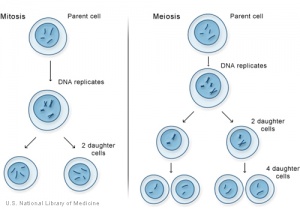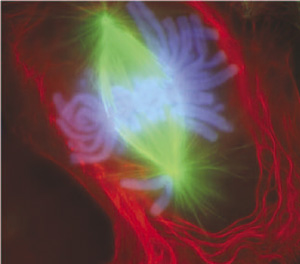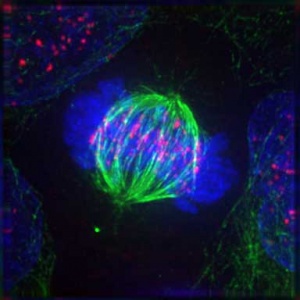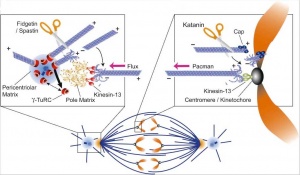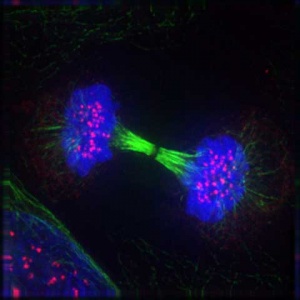Cell Division - Mitosis: Difference between revisions
| Line 10: | Line 10: | ||
:{{Template:Cell Division Links}} | :{{Template:Cell Division Links}} | ||
==Some Recent Findings== | == Some Recent Findings == | ||
{| | |||
|-bgcolor="F5FAFF" | |||
| | |||
* <ref name="PMID"><pubmed></pubmed></ref> | |||
|} | |||
==Movies== | ==Movies== | ||
Revision as of 09:17, 20 April 2011
Introduction
Normal cell division in all cells, except germ cells, occurs by 2 mechanical processes that initially divide the nucleus then the cell cytoplasm.
- Mitosis segregation of chromosomes and formation of 2 nuclei
- Cytokinesis splitting of the cell as a whole into 2 daughter cells
- Cell Division Milestones
- Recent Nobel Prizes- 2001 Cell Cycle, 2002 Cell Death
| Cell Division Links: meiosis | mitosis | Lecture - Cell Division and Fertilization | spermatozoa | oocyte | fertilization | zygote | Genetics |
Some Recent Findings
Movies
<wikiflv height= width="400" height="388" autostart="true" repeat="true" logo="false">Mitosis 01.flv|File:Mitosis 01 icon.jpg</wikiflv>
Mitosis Movie[2] See also: Movie - Mitosis
Cell Changes
- Nucleus
- Chromosome condensation
- Nuclear envelope breakdown
- Cytoplasm
- Cytoskeleton reorganization
- Spindle formation (MT) Contractile ring (MF)
- Organelle redistribution
- Mitosis Energy
- Cell division uses up a lot of energy, so cells ensure they have enough resources to complete the job before committing to it.
Mitosis Phases
- Based on light microscopy of living cells light and electron microscopy of fixed and stained cells
- 5 Phases - prophase, prometaphase, metaphase, anaphase, and telophase
- Cytokinesis 6th stage overlaps the end of mitosis
MBC The stages of mitosis and cytokinesis in an animal cell
Interphase
- not a mitotic phase (discussed in cell cycle)
- Chromosomes dispersed in nucleus
- Gene expression
- Cytoskeleton and cell organelles - Distributed and functioning
- Mitochondria undergo independent proliferation/division
Chromosome Changes
Prophase
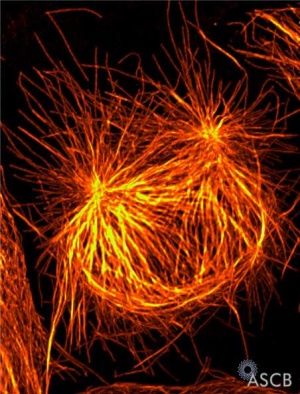
- Chromosome DNA has been earlier duplicated (S Phase)
- Chromosomes begin condensing
- Chromosome pairs (chromatids) held together at centromere
- Microtubules disassemble
- Mitotic spindle begins to form
Spindle Apparatus
- 3 sets of microtubules - (+) ends point away from centrosome at each pole.
- astral microtubules - anchor the pole end in position
- kinetochore microtubules - connected to chromosomes
- polar microtubules - form the structure of the spindle apparatus
Spindle Apparatus EM | Spindle Apparatus | MBC Movie- Microtubule dynamics during mitosis
At end of prophase nuclear envelope breaks down
Prometaphase
- Microtubules now enter nuclear region
- Nuclear envelope forms vesicles around mitotic spindle
- Kinetochores form on centromere attach to some MTs of spindle
Dynamic instability and the capture of chromosomes
Centromeric attachment of microtubules
At end of prometaphase chromosomes move to metaphase plate
Metaphase
- Kinetochore MTs align chromosomes in one midpoint plane
Proposed alternative mechanisms for chromosome congression
Metaphase ends when sister kinetochores separate
Anaphase
- Separation of sister Kinetochores
- shortening of Kinetochore microtubules pulls chromosome to spindle pole
Anaphase ends as nuclear envelope (membrane) begins to reform
Telophase
- Chromosomes arrive at spindle poles
- Kinetochore MTs lost
- Condensed chromosomes begin expanding
- Continues through cytokinesis
Links: Figure 19-41 Microtubule dynamics during mitosis | Figure 19-34. The stages of mitosis and cytokinesis in an animal cell | Cytokinetic abscission: cellular dynamics at the midbody
Cytokinesis
- Division of cytoplasmic contents
- Contractile ring forms at midpoint under membrane
- Microfilament ring - contracts forming cleavage furrow
- myosin II is the motor
- Eventually fully divides cytoplasm
Links: Cytokinesis | Cytokinesis in Plants
Cell Organelles
Mitochondria
- Divide independently of cell mitosis
- distributed into daughter cells
Peroxisomes
- localise at spindle poles
Endoplasmic Reticulum
Golgi
- 2 processes - disassembly and reassembly[4]
- Golgi stack undergoes a continuous fragmentation process
- fragments are distributed into daughter cells
- are reassembled into new Golgi stacks
Disassembly
- Unstacking - mediated by two mitotic kinases (cdc2 and plk)
- Vesiculation - mediated by COPI budding machinery ARF1 and the coatomer complex
Reassembly
- Fusion - formation of single cisternae by membrane fusion
- Restacking - requires dephosphorylation of Golgi stacking proteins by protein phosphatase PP2A
References
- ↑ <pubmed></pubmed>
- ↑ <pubmed>12105179</pubmed>
- ↑ Russan NM. Let's Build a Spindle. ASCB Image & Video Library. 2008;CYT-190. Available at: http://cellimages.ascb.org/u?/p4041coll12,521
- ↑ <pubmed>18156178</pubmed>
Reviews
Articles
Search Pubmed
Search Pubmed: mitosis
Additional Images
- Centriole duplication.jpg
Centriole duplication
Cite this page: Hill, M.A. (2024, April 19) Embryology Cell Division - Mitosis. Retrieved from https://embryology.med.unsw.edu.au/embryology/index.php/Cell_Division_-_Mitosis
- © Dr Mark Hill 2024, UNSW Embryology ISBN: 978 0 7334 2609 4 - UNSW CRICOS Provider Code No. 00098G
